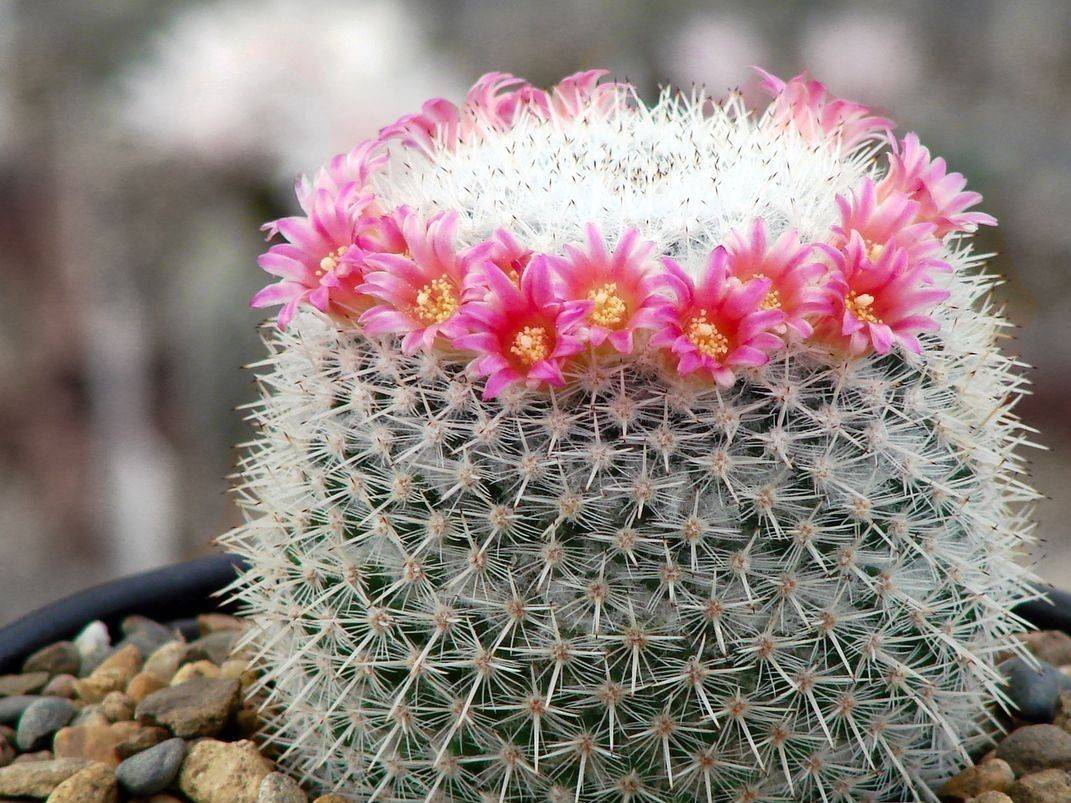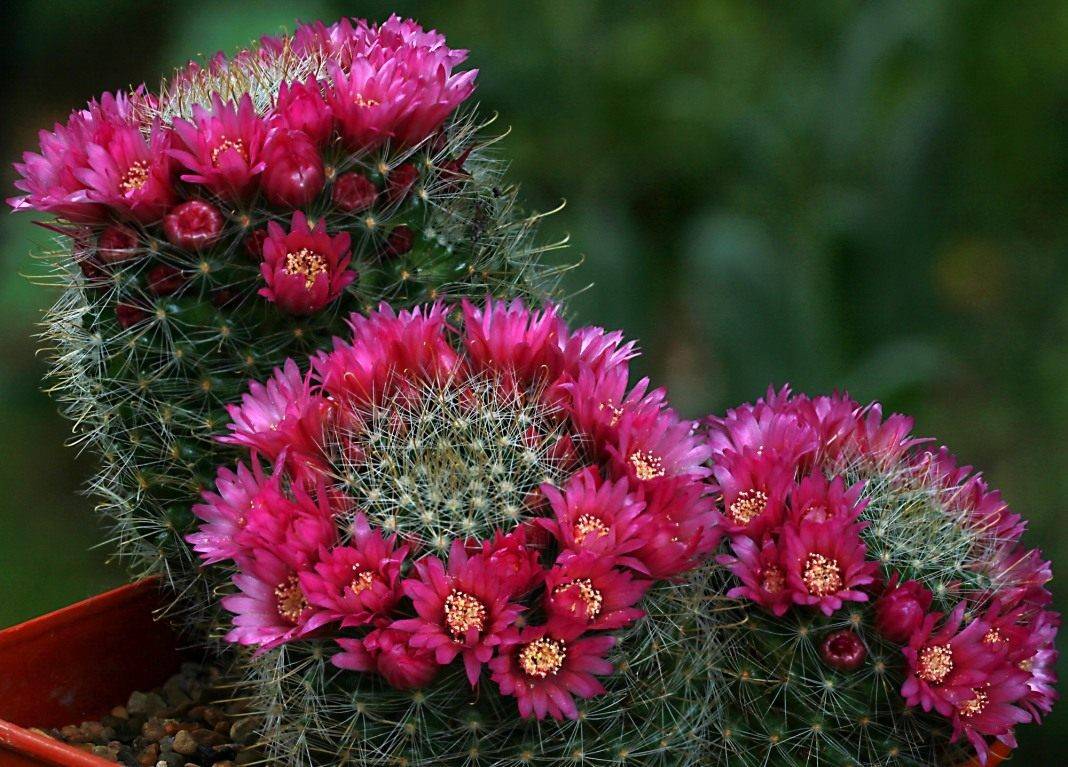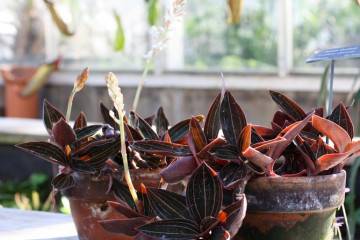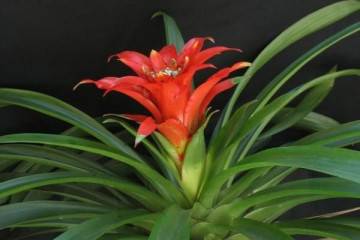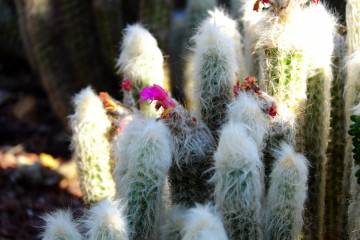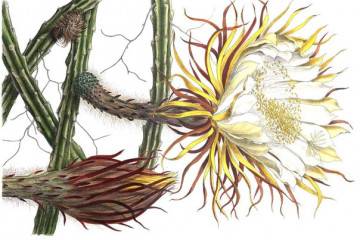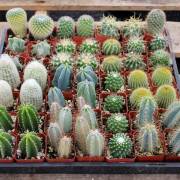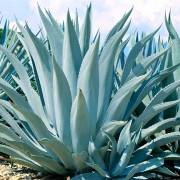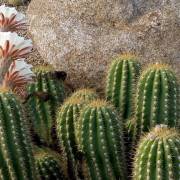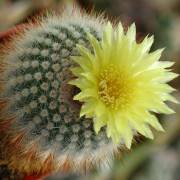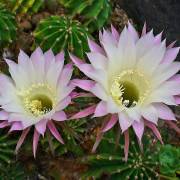Mammillaria cactus - types and care at home
Content:
Cacti are exotic and varied plants. Many people consider growing them their real hobby. One of its varieties, Mammilaria, is quite unpretentious to care for, so even a novice gardener can grow it. But even so, before planting this cactus at home, you should carefully familiarize yourself with the representatives of the variety and find out how to care for it.
Mammillaria cactus: types and description
In total, about 200 varieties of this species are known. Most of them are used for growing at home. At the same time, thanks to breeders, the number of varieties is increasing every year. For those who have just decided to grow cacti, it is better to choose from the following types of mammillaria cactus:
- long-papillary mammillaria (another name is Longimamma). Quite a large species, can reach 30 cm in height and 14 cm in width. Its flowers are conical-cylindrical;
- Zeilman. It has an elongated cylindrical trunk with spines bent inward. During flowering, pink buds form a graceful wreath at its top;
- Mammillaria Bokasana. A small variety that reaches a height of no more than 6 cm. It has hard hook-shaped spines. The Bokasan cactus is covered with white hairs outside, resembling fluff;
- Karma. One of the most common indoor varieties. It has the shape of a small ball covered with white or brown hairs. It is quite unpretentious and tolerates small frosts quite well;
- Gracilis. A small representative of its kind. It can be round, disc-shaped, or cylindrical. It differs from most relatives by the presence of not ribs, but small papillae, from which flowers sprout;
- Luthi. At first glance at this plant, it is difficult to believe that it belongs to the Cactus family. Its thorns rather resemble white fluff, which creates a unique look. During flowering, the top is decorated with a lush bud of a violet-white hue.
In addition to the above, the following varieties are often used in home floriculture:
- Prolifera;
- Elongata;
- bokass;
- Mammillaria Bakeberg;
- Wilda;
- Haniana;
- satin, or Bombicin;
- Carmen;
- Blossfeld's cactus.
Mammillaria cactus: home care
Although this succulent is quite unpretentious, it is better to know in advance some of the features that will help in proper cultivation. In order to provide proper home care for mammillaria, basic requirements for proper growth must be met.
Temperature
For succulents of this variety, a temperature of 15 ° C to 25 ° C will be suitable. In particularly hot weather, you need to provide shading. If the cactus is allowed to overheat, it can wrinkle and burn.
Lighting
Mammillaria is very fond of sunlight. If it is not enough, then the flower may die. It is best to place the pot on a balcony or windowsill on the south side of the house.In winter, additional lighting with lamps can be provided if necessary.
Watering
The watering regime at different times of the year is very different. In winter, this is done no more than once every 2-3 weeks. In spring and summer, the frequency increases. It is influenced by the size of the capacity and the cactus itself. But on average, the plant needs to be watered in the warm season every few days. In any case, do not exceed the recommended amount, as this may affect the health of the succulent.
Spraying and moisture
The cactus does quite well without spraying. Sometimes, on especially hot days, it can be sprayed with a spray bottle.
It's the same with humidity. Mammillaria feels good in a room with dry air, so it does not need additional humidification of the room.
Soil and dressing
For planting, you need to prepare a mixture consisting of the following components:
- sod land;
- leafy land;
- sand.
Everything is taken in a 1: 1: 1 ratio. It will not hurt to add brick chips or limestone to the substrate. The land for it must be selected with a high content of mineral impurities. It must be porous and permeable.
Rest period and features of winter care
With the onset of cold weather, the cactus needs to organize a dormant period. To do this, it is desirable for him to provide a temperature of 8-10 ° C. The number of watering and fertilizing at this time is also reduced. The dormant period is very important for the life of the plant, as rest has a stimulating effect on the upcoming flowering.
When and how it blooms
With proper wintering, the first buds of a cactus can appear as early as January. In this case, the number of watering increases, then the first flowers will bloom in March. During the ripening of the buds, they should be protected from direct exposure to sunlight, otherwise they may die.
Reproduction
Mammillaria reproduces in two ways: shoots and seeds. At the first, a suitable shoot is selected, they wait until the cut site dries up, and planted in wet sand.
Seed propagation is the most popular method. To do this, they are soaked in a manganese solution and planted in a shallow container filled with wet sand and covered with a transparent film. Seeds germinate at a temperature of 22-25 ° C. When the first sunrises appear, the film is removed, and when the first thorns appear, the seedlings are seated in separate pots.
Transfer
It is recommended to replant adult plants every 2-3 years, young plants - annually. This procedure is performed in the spring. Before this, for 5 days, the cactus is stopped to water. Then it is taken out along with a lump of earth and transferred to a new pot. New soil is poured in and slightly pressed down.
Growing problems and disease
Most often, mammillaria is exposed to diseases such as late blight and spotting. To combat them, the plant should be periodically treated with fungicides. With an excessive amount of watering, the cactus can rot. If it is noticed and removed in time, the plant will retain its health. This requires drying the soil and reducing the frequency of watering.
The most common pests on cacti are scale insects, spider mites and nematodes. And if the first two are easy to cope with with the help of insecticides, then the last problem is very difficult to detect, since it develops in the root system of the cactus.If, nevertheless, it turned out to detect pests, then you need to remove the bubbles on the roots, rinse them with warm water and treat with activated carbon.
By observing all the recommended requirements, you can easily grow a thorny plant at home. And if you're lucky, it will delight you with its unusual flowering next year.
